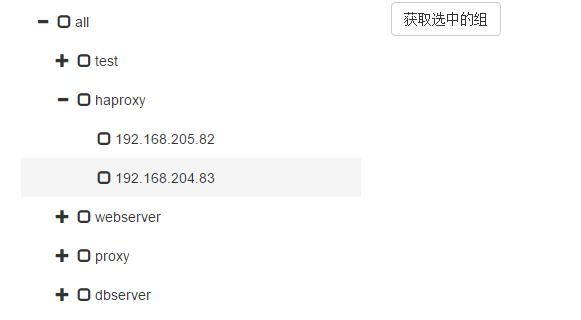python将ansible配置转为json格式实例代码
ansible的配置文件举例如下,这种配置文件不利于在前端的展现,因此,我们用一段简单的代码将ansible的配置文件转为json格式的:
|
1
2
3
4
5
6
7
8
9
10
11
12
13
14
15
16
17
18
19
20
21
22
|
[webserver]192.168.204.70192.168.204.71[dbserver]192.168.204.72192.168.204.73192.168.204.75[proxy]192.168.204.76192.168.204.77192.168.204.78[test]192.168.204.79192.168.204.80[haproxy]192.168.205.82192.168.204.83 |
用python将ansible配置转为json格式,python代码如下:
|
1
2
3
4
5
6
7
8
9
|
import ConfigParserimport jsondict_result = {}cf = ConfigParser.ConfigParser(allow_no_value=True)cf.read('/etc/ansible/hosts.test')secs = cf.sections()for sec in secs: dict_result[sec] = cf.options(sec)print json.dumps(dict_result) |
转换结果如下(python版本使用2.7版本的):
/usr/local/python/bin/python /tmp/test.py
{"test": ["192.168.204.79", "192.168.204.80"], "haproxy": ["192.168.205.82", "192.168.204.83"], "webserver": ["192.168.204.70", "192.168.204.71"], "proxy": ["192.168.204.76", "192.168.204.77", "192.168.204.78"], "dbserver": ["192.168.204.72", "192.168.204.73", "192.168.204.75"]}
转换成json文件就方便在前端进行展示了,使用Flask提供json格式的接口如下:
|
1
2
3
4
5
6
7
8
9
10
11
|
#获取ansible分组@app.route('/web_test/ansible')def web_test_ansible(): dict_result = {} cf = ConfigParser.ConfigParser(allow_no_value=True) cf.read('/etc/ansible/hosts.test') secs = cf.sections() for sec in secs: dict_result[sec] = cf.options(sec) return json.dumps(dict_result) |
然后前端代码(使用bootstrap treeview)如下:
|
1
2
3
4
5
6
7
8
9
10
11
12
13
14
15
16
17
18
19
20
21
22
23
24
25
26
27
28
29
30
31
32
33
34
35
36
37
38
39
40
41
42
|
<script src="/static/js/bootstrap-treeview.js"></script> <script type="text/javascript"> $(document).ready(function () { $('#btn-get-hostgroup').click(function () { getAllCheck = $('#hostgrouptree').treeview('getChecked'); for (var i = 0; i < getAllCheck.length; i++) { console.log(getAllCheck[i].text); } }); $.ajax({ url: '/web_test/ansible', type: 'GET', success: function (data) { result = JSON.parse(data); nodes = []; for (var hostgroup in result) { var nodeshostgroup = []; hosts = result[hostgroup]; for (var i = 0; i < hosts.length; i++) { nodeshostgroup.push({text: hosts[i], selectable:false}); } nodes.push({text: hostgroup, nodes: nodeshostgroup, selectable:false}); } $('#hostgrouptree').treeview({data: [{text: 'all', nodes: nodes, selectable:false}], showCheckbox: true, showBorder:false}); } }); }); </script>{% endblock %}{% block page_content %} <div class="col-md-4" id="hostgrouptree"> </div> <div class="col-md-6"> <button id="btn-get-hostgroup" type="button" class="btn btn-default">获取选中的组</button> </div> |
ansible的配置文件在前端的展示如下,获取ansible选中的组,利用ansible命令就可以实现一些简单的自动化操作了:

感谢阅读,希望能帮助到大家,谢谢大家对本站的支持!










